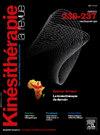Déterminants de la prescription de kinésithérapie respiratoire chez le nourrisson de moins de 12 mois en médecine de ville
Q4 Medicine
引用次数: 0
Abstract
Contexte et objectifs
Malgré l’avis de la Haute Autorité de Santé, défavorable à la prescription de kinésithérapie respiratoire (KR) de désencombrement bronchique chez les nourrissons de moins de 12 mois, de nombreux médecins continuent à la prescrire. L’objectif était de comprendre quels sont les déterminants et les attentes des médecins à travers cette prescription.
Méthodes
Il s’agissait d’une étude phénoménologique basée sur des entretiens semi-directifs de médecins prescripteurs de KR. Un cadre théorique d’analyse du comportement des professionnels de santé lors de la mise en œuvre de nouvelles recommandations a été utilisé. La saturation des données a été recherchée. Les verbatims ont été analysés et synthétisés par deux chercheurs indépendants.
Résultats
Douze médecins ont été interviewés. Quatre grandes catégories ont été dégagées : la connaissance des recommandations de bonne pratique (RBP) ; l’attitude du prescripteur face à ces RBP ; les raisons qui l'amenaient à prescrire de la KR ; ses attentes par rapport à la KR. Deux catégories de déterminants à la prescription (forts et faibles), correspondant au cadre théorique, ont été trouvées.
Conclusion
La prescription de KR en médecine de ville est le fruit d’attentes réelles des prescripteurs et de déterminants environnementaux. Cette prescription n’est pas en contradiction avec les recommandations de la HAS. Le rôle du kinésithérapeute doit être redéfini au regard des attentes des prescripteurs.
Niveau de preuve
NA.
Background and objectives
Despite the HAS's opinion against the prescription of respiratory physiotherapy (RP) for bronchial decongestion in infants under 12 months, many doctors continue to prescribe it. The aim of this study is to understand the determinants and expectations of doctors with regard to this prescription.
Methods
This was a phenomenological study based on semi-structured interviews with doctors who prescribed RP. A theoretical framework analyzing the behavior of healthcare professionals when implementing new recommendations was used. Data saturation was sought. The verbatims were analyzed and summarized by two independent researchers.
Results
Twelve doctors were interviewed. Four main categories were identified: knowledge of the recommendations for good practice (RGP); the prescriber's attitude to these RGP; his reasons for prescribing RP; the prescriber's expectations towards RP. Two categories of prescribing determinants (strong and weak), corresponding to the theoretical framework, were found.
Conclusion
Prescribing RP in primary care is the result of real expectations on the part of prescribers and environmental determinants. This prescription does not contradict HAS recommendations. The role of the physiotherapist needs to be redefined in the light of prescribers’ expectations.
Level of evidence
NA.
12个月以下婴儿呼吸物理治疗处方的决定因素
尽管法国卫生当局建议不建议使用呼吸物理疗法(KR)治疗12个月以下婴儿的支气管阻塞,但许多医生仍继续使用这种疗法。目的是通过这个处方了解医生的决定因素和期望是什么。这是一项现象学研究,基于对开KR处方的医生的半指导性访谈,并使用了一个理论框架来分析卫生专业人员在实施新建议时的行为。对数据的饱和度进行了搜索。这些逐字表由两位独立的研究人员分析和综合。采访了12名医生。确定了四个主要类别:良好实践建议知识(OPR);处方方对这些PRGs的态度;他开KR的原因;发现了与理论框架相对应的两类处方决定因素(强和弱)。结论城市医学中的KR处方是处方者和环境决定因素的真实期望的结果。这与HAS的建议并不矛盾。物理治疗师的角色必须根据处方者的期望重新定义。证据水平。尽管HAS反对为12个月以下的婴儿开呼吸物理疗法(RP)治疗支气管充血,但许多医生继续开它。本研究的目的是了解医生对这种处方的决定因素和期望。这是一项基于对开RP的医生的半结构化访谈的现象学研究。使用了一个理论框架,分析医疗保健专业人员在实施新建议时的行为。需要数据饱和度。两名独立研究人员分析和总结了这些术语。结果12名医生接受了采访。确定了四个主要类别:关于良好做法建议的知识;处方者对这些rpg的态度;开公共关系处方的理由;处方者对RP的期望。根据理论框架,发现了两类处方决定因素(强和弱)。结论:初级保健中的RP处方是对处方者和环境决定因素的真实期望的结果。本处方不与HAS的建议相矛盾。这是一个很好的例子,说明了为什么你可以在你的网站上找到更多关于这个主题的信息。证据的水平。
本文章由计算机程序翻译,如有差异,请以英文原文为准。
求助全文
约1分钟内获得全文
求助全文
来源期刊

Kinesitherapie
Medicine-Rehabilitation
CiteScore
0.40
自引率
0.00%
发文量
135
期刊介绍:
Kinésithérapie, la revue adresse aux praticiens et aux étudiants qui veulent lire des informations accessibles et utiles. Ce est la première revue francophone paramédicale à être indexée dans une base de données internationale - Cumulative Index to Nursing and Allied Health Literature : CINAHL.
 求助内容:
求助内容: 应助结果提醒方式:
应助结果提醒方式:


